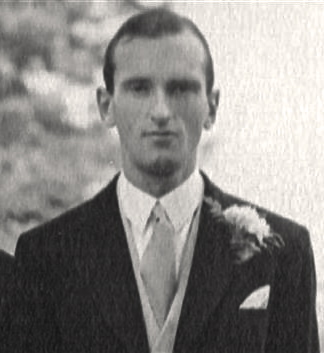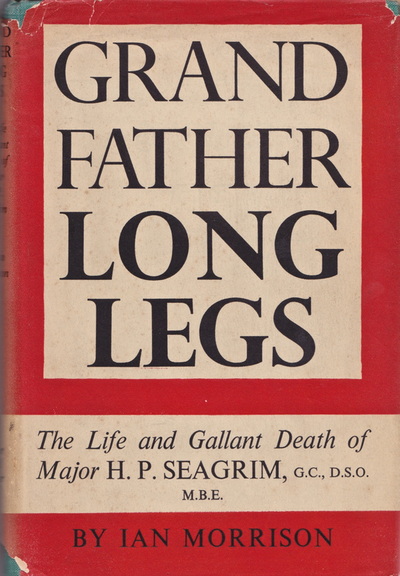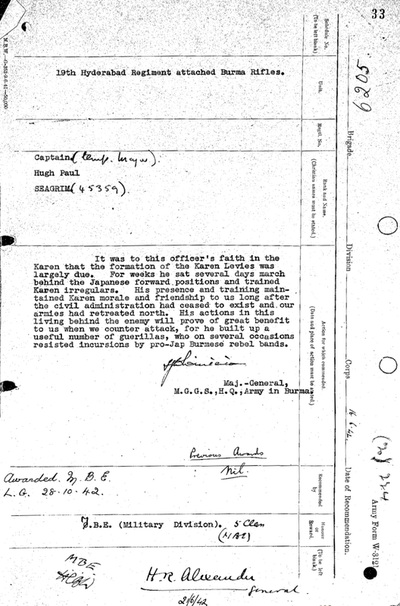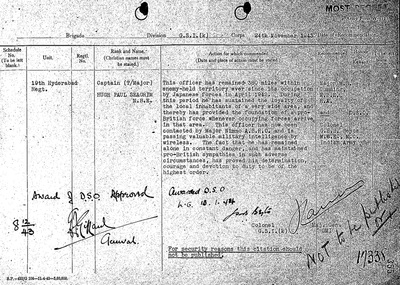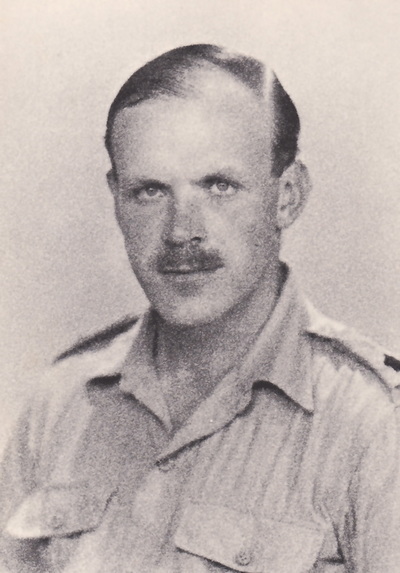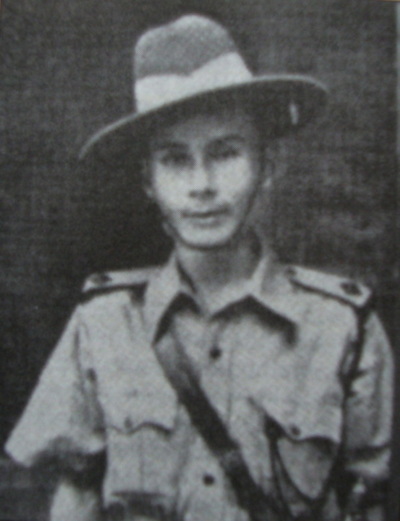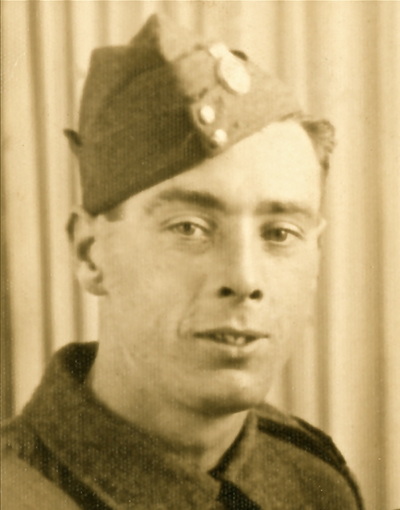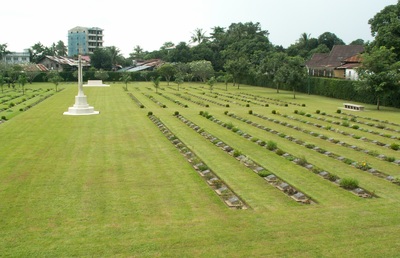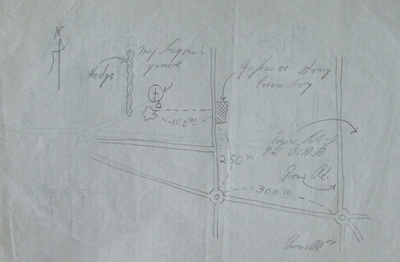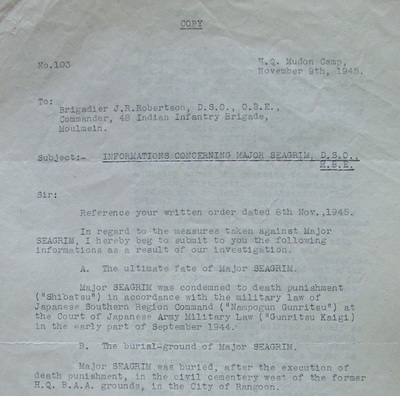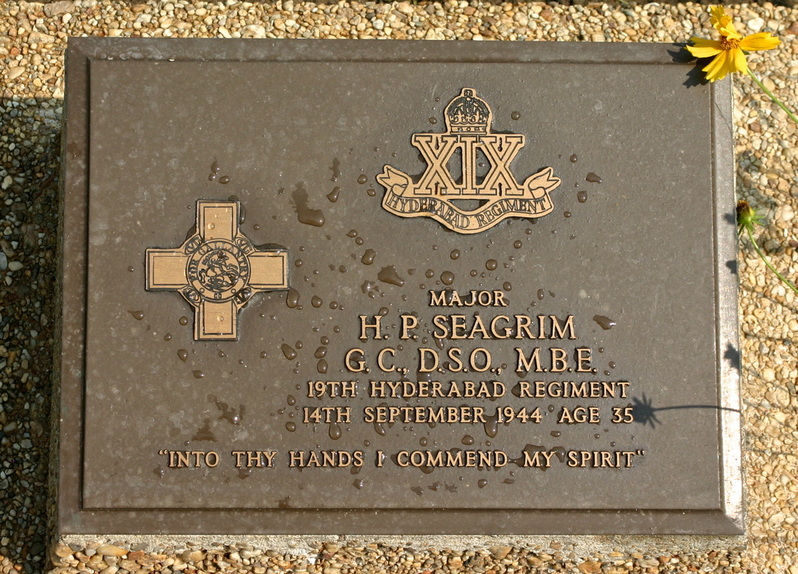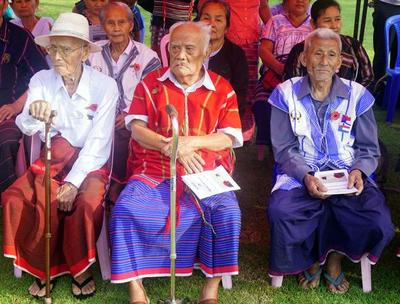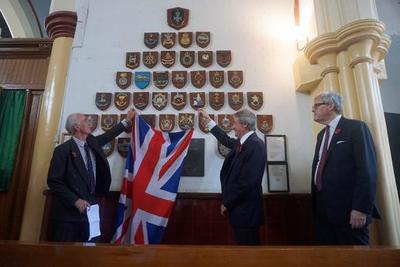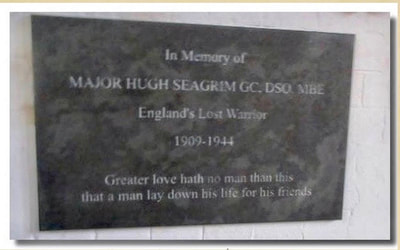Major Hugh Paul Seagrim G.C. D.S.O. M.B.E.
 Major H. P. Seagrim.
Major H. P. Seagrim.
Major H.P. Seagrim, known to the Japanese, as the 'Big Master', was not a Chindit and as such does not, I suppose belong on these website pages. However, he was such a special character and his contribution to the Burma Campaign so great, that I wanted to include his story amongst those already remembered here. This is by no means a complete narrative in regards to his story, for that you must seek out and read, Ian Morrison's biography, entitled 'Grandfather Long Legs'.
Hugh Paul Seagrim was born in the English county of Hampshire, on the 24th March 1909. He attended Norwich School, where he was a prefect and a great lover of sports. After leaving education he went to the Royal Military College at Sandhurst, after which he took up a commission in the Indian Army, beginning 31st January 1929 and served initially with the Kumaon Rifles. After a period in the Hyderabad Regiment, Seagrim was posted to the 1st Battalion the Burma Rifles and it was with this unit that he attained the rank of Major and served in Burma during the years of WW2.
From the book, 'A History of Norwich School', by combined authors, Richard Harries, Paul Cattermole and Peter Mackintosh, comes this short biography of their famous alumni:
Of all these superlatively brave men (from Norwich School), one was incomparable, Hugh Paul Seagrim G.C., D.S.O., M.B.E., since the action for which he is celebrated was the result, not of the decision of a moment, taken in hot blood, but of a deliberate and cool intention to do something which he knew could only lead to brutal imprisonment and a cruel death.
Of the Seagrim brothers, Hugh was the youngest. Another brother, Derek Anthony Seagrim had already been awarded the Victoria Cross for his efforts during the North Africa campaign in WW2. Hugh was at the school from 1917-1927, was a School Prefect and 1st XI soccer goal-keeper. Hugh wanted to become a doctor but his father died during his last year at school and there was not enough money to send him to a university. Since his four brothers were in the Army, he decided to join the Navy, but was found to be colour-blind, so he, too, went to Sandhurst.
He joined the Indian Army and eventually the Burma Rifles, becoming deeply attached to the country and its people. He was keen on exploring remote and mountainous areas in the company of some of the local Karens and in this way got to know both the terrain and his own men extremely well. As a result of his local knowledge during the retreat from Burma, Hugh went back behind the Japanese lines and organised a Karen resistance movement for which he was awarded the M.B.E. in the summer of 1942.
He stayed behind the Japanese lines for over a year, passing valuable military intelligence to the Army by radio, work which led to the award of the D.S.O. in 1943. Part of that citation reads:
"The fact that he has remained alone in constant danger and has maintained pro-British sympathies in some adverse circumstances, has proved his determination, courage and devotion to be of the highest order."
The Japanese worked hard to search out Major Seagrim during this time, they even named him, 'The Big Master', in recognition of the great loyalty he was awarded by the local Karen tribesmen. His guerrilla force enjoyed much support from Karen civilians despite a series of brutal Japanese reprisal killings against Karen villages. His force was gradually wiped out by a concentrated Japanese manhunt. To prevent further bloodshed against his beloved Karens, Seagrim eventually surrendered himself to the Japanese forces on 15th March 1944. He and eight of his Karen companions were executed by the Japanese in mid-September at the Kemmendine Cemetery in Rangoon.
Hugh Seagrim left an indelible impression upon all those who ever met him. Harold Braund, from the Bombay-Burmah Trading Corporation and later an officer with the Chin Levies, remembered meeting Hugh at church. From his own book 'Distinctly I Remember':
I became a regular worshiper at the Anglican Catherdral in Rangoon, to which I owe a close, but short-lived association with 'Stooky' Seagrim, that remarkable man who is unlikely to be replaced as the most unforgettable character I have ever met. His immortal wartime story of valour in isolation and self-sacrificial death has been enshrined for posterity in Ian Morrison's book Grandfather Longlegs.
Stooky and a brother officer used to motor-cycle in from Mingaladon Cantonment for Evensong. As often as not, after the service, they would come back to my rooms for a drink and sometimes a bite of food. In my own copy of Grandfather Longlegs I have pencilled this note:
"We always got involved in discussion, sometimes religious, sometimes not, but usually serious; despite which, Stooky's manner of arguing promoted laughter sooner or later."
He was a dynamic, infectious character; and, had he survived the war, there is little doubt that he would have carried out his oft-declared intention of leaving the Army and becoming a missionary in Burma.
Seen below are a gallery of images in relation to this story. Please click on any image to bring it forward on the page.
Hugh Paul Seagrim was born in the English county of Hampshire, on the 24th March 1909. He attended Norwich School, where he was a prefect and a great lover of sports. After leaving education he went to the Royal Military College at Sandhurst, after which he took up a commission in the Indian Army, beginning 31st January 1929 and served initially with the Kumaon Rifles. After a period in the Hyderabad Regiment, Seagrim was posted to the 1st Battalion the Burma Rifles and it was with this unit that he attained the rank of Major and served in Burma during the years of WW2.
From the book, 'A History of Norwich School', by combined authors, Richard Harries, Paul Cattermole and Peter Mackintosh, comes this short biography of their famous alumni:
Of all these superlatively brave men (from Norwich School), one was incomparable, Hugh Paul Seagrim G.C., D.S.O., M.B.E., since the action for which he is celebrated was the result, not of the decision of a moment, taken in hot blood, but of a deliberate and cool intention to do something which he knew could only lead to brutal imprisonment and a cruel death.
Of the Seagrim brothers, Hugh was the youngest. Another brother, Derek Anthony Seagrim had already been awarded the Victoria Cross for his efforts during the North Africa campaign in WW2. Hugh was at the school from 1917-1927, was a School Prefect and 1st XI soccer goal-keeper. Hugh wanted to become a doctor but his father died during his last year at school and there was not enough money to send him to a university. Since his four brothers were in the Army, he decided to join the Navy, but was found to be colour-blind, so he, too, went to Sandhurst.
He joined the Indian Army and eventually the Burma Rifles, becoming deeply attached to the country and its people. He was keen on exploring remote and mountainous areas in the company of some of the local Karens and in this way got to know both the terrain and his own men extremely well. As a result of his local knowledge during the retreat from Burma, Hugh went back behind the Japanese lines and organised a Karen resistance movement for which he was awarded the M.B.E. in the summer of 1942.
He stayed behind the Japanese lines for over a year, passing valuable military intelligence to the Army by radio, work which led to the award of the D.S.O. in 1943. Part of that citation reads:
"The fact that he has remained alone in constant danger and has maintained pro-British sympathies in some adverse circumstances, has proved his determination, courage and devotion to be of the highest order."
The Japanese worked hard to search out Major Seagrim during this time, they even named him, 'The Big Master', in recognition of the great loyalty he was awarded by the local Karen tribesmen. His guerrilla force enjoyed much support from Karen civilians despite a series of brutal Japanese reprisal killings against Karen villages. His force was gradually wiped out by a concentrated Japanese manhunt. To prevent further bloodshed against his beloved Karens, Seagrim eventually surrendered himself to the Japanese forces on 15th March 1944. He and eight of his Karen companions were executed by the Japanese in mid-September at the Kemmendine Cemetery in Rangoon.
Hugh Seagrim left an indelible impression upon all those who ever met him. Harold Braund, from the Bombay-Burmah Trading Corporation and later an officer with the Chin Levies, remembered meeting Hugh at church. From his own book 'Distinctly I Remember':
I became a regular worshiper at the Anglican Catherdral in Rangoon, to which I owe a close, but short-lived association with 'Stooky' Seagrim, that remarkable man who is unlikely to be replaced as the most unforgettable character I have ever met. His immortal wartime story of valour in isolation and self-sacrificial death has been enshrined for posterity in Ian Morrison's book Grandfather Longlegs.
Stooky and a brother officer used to motor-cycle in from Mingaladon Cantonment for Evensong. As often as not, after the service, they would come back to my rooms for a drink and sometimes a bite of food. In my own copy of Grandfather Longlegs I have pencilled this note:
"We always got involved in discussion, sometimes religious, sometimes not, but usually serious; despite which, Stooky's manner of arguing promoted laughter sooner or later."
He was a dynamic, infectious character; and, had he survived the war, there is little doubt that he would have carried out his oft-declared intention of leaving the Army and becoming a missionary in Burma.
Seen below are a gallery of images in relation to this story. Please click on any image to bring it forward on the page.
Another soldier that came int contact with Major Seagrim, was Corporal Roy Pagani MM who had served with the East Surrey Regiment in WW2. Corporal Pagani had been captured by the Japanese at the fall of Singapore in early 1942. As a POW, he was sent to work on the infamous Burma-Thailand Railway and it was from this location that he effected a daring escape. After several weeks on the run, Pagani, by this time exhausted, starving and nearing collapse was found by Karen tribesmen and taken to Major Seagrim. He spent a good while in the company of the Major and after recuperating from his ordeal, assisted Seagrim in his clandestine activities against the Japanese.
In the book, 'The Flame of Freedom', written by author Robert Hammond, Roy Pagani recounts the lead up to Hugh Seagrim's arrest by the Kempaitai (Japanese Military Police) and his eventual execution:
Eventually, the Japanese began to take reprisals against the Karen villages in the area, in an attempt to flush out Major Seagrim. When he heard of this he decided that he must spare these innocent Karens any further suffering on his behalf, so he came out of the jungle and surrendered to local Kempaitai officer Captain Motoichi Inoue in March 1944. From there he was taken to the New Law Courts in Rangoon for interrogation. There is no evidence that he was tortured to the same extent as I was (Pagani), but any Karens suspected of being connected with him certainly were.
It seems that the Japanese, even the Kempeitai, respected his courage and were also hopeful that they might persuade him to use his influence with the Karens to co-operate with the Japanese. This he refused to do. Later he was moved to the cells in Rangoon Jail and, on the 2nd September 1944, was court-martialled and condemned to death. Taking all the blame on himself, he made a final plea for the release of the Karens, but this fell on deaf ears. Later on he and seven others were taken by truck to Kemmendine Cemetery where they were shot.
His execution was one more example of the treachery, deceit and hypocrisy so often shown by the Japanese. Seagrim had surrendered voluntarily to save the Karens from further ill-treatment. He had been given an assurance that he would be treated as a prisoner of war and that persecution of the Karens would cease after his surrender.
For all their lip-service to courage and the`bushido' code, they usually behaved like this and it stained the honour of their Armed Forces, earning them the contempt and loathing of all decent men. Needless to say, they also continued to terrorise the Karens until all resistance was finally crushed through fear of reprisals against innocent people. But in 1945 they were to pay a terrible price for their broken promises when the Karens, newly-armed, fell upon their weary forces as they tried to retreat from Burma to Siam and slaughtered them without mercy.
Executed with Seagrim were seven Karens including my old friend, Ah Din, and Lieutenant Ba Gyaw. Saw Po Hla, Ta Roe, Saw Digay, Saw Henry and six others were sentenced to eight years hard labour.
The epic tales of Major Seagrim's work with the Karen tribespeople had also reached the ears of the Chindits from the first Wingate expedition in 1943. Many of the soldiers from the Burma Rifles on Operation Longcloth were of Karen origin. One Chindit commando, L/Cpl. Gerald Desmond was directly interrogated about Seagrim, after his own capture in April that year. The Japanese continually asked Lance Corporal Desmond if he knew anything of the British officer working in conjunction with Karen guerrillas in Northern Burma. Of course Gerald could tell them nothing.
In the book, 'The Flame of Freedom', written by author Robert Hammond, Roy Pagani recounts the lead up to Hugh Seagrim's arrest by the Kempaitai (Japanese Military Police) and his eventual execution:
Eventually, the Japanese began to take reprisals against the Karen villages in the area, in an attempt to flush out Major Seagrim. When he heard of this he decided that he must spare these innocent Karens any further suffering on his behalf, so he came out of the jungle and surrendered to local Kempaitai officer Captain Motoichi Inoue in March 1944. From there he was taken to the New Law Courts in Rangoon for interrogation. There is no evidence that he was tortured to the same extent as I was (Pagani), but any Karens suspected of being connected with him certainly were.
It seems that the Japanese, even the Kempeitai, respected his courage and were also hopeful that they might persuade him to use his influence with the Karens to co-operate with the Japanese. This he refused to do. Later he was moved to the cells in Rangoon Jail and, on the 2nd September 1944, was court-martialled and condemned to death. Taking all the blame on himself, he made a final plea for the release of the Karens, but this fell on deaf ears. Later on he and seven others were taken by truck to Kemmendine Cemetery where they were shot.
His execution was one more example of the treachery, deceit and hypocrisy so often shown by the Japanese. Seagrim had surrendered voluntarily to save the Karens from further ill-treatment. He had been given an assurance that he would be treated as a prisoner of war and that persecution of the Karens would cease after his surrender.
For all their lip-service to courage and the`bushido' code, they usually behaved like this and it stained the honour of their Armed Forces, earning them the contempt and loathing of all decent men. Needless to say, they also continued to terrorise the Karens until all resistance was finally crushed through fear of reprisals against innocent people. But in 1945 they were to pay a terrible price for their broken promises when the Karens, newly-armed, fell upon their weary forces as they tried to retreat from Burma to Siam and slaughtered them without mercy.
Executed with Seagrim were seven Karens including my old friend, Ah Din, and Lieutenant Ba Gyaw. Saw Po Hla, Ta Roe, Saw Digay, Saw Henry and six others were sentenced to eight years hard labour.
The epic tales of Major Seagrim's work with the Karen tribespeople had also reached the ears of the Chindits from the first Wingate expedition in 1943. Many of the soldiers from the Burma Rifles on Operation Longcloth were of Karen origin. One Chindit commando, L/Cpl. Gerald Desmond was directly interrogated about Seagrim, after his own capture in April that year. The Japanese continually asked Lance Corporal Desmond if he knew anything of the British officer working in conjunction with Karen guerrillas in Northern Burma. Of course Gerald could tell them nothing.
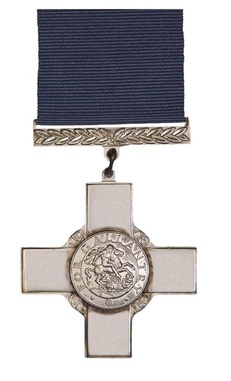 The George Cross Medal.
The George Cross Medal.
Transcribed below are the official recommendations for all of Major Seagrim's medallic awards, starting with the M.B.E. in October 1942:
The M.B.E. awarded in the summer of 1942, after the retreat from Burma.
It was to this officer's faith in the Karen that the formation of the Karen Levies was largely due. For weeks he sat several days' march behind the Japanese forward positions and trained Karen irregulars. His presence and training maintained Karen morale and friendship to us long after the civil administration had ceased to exist and our armies had retreated north. His actions in thus living behind the enemy will prove of great benefit to us when we counter-attack, for he built up a useful number of guerrillas who on several occasions resisted incursions by pro-Japanese Burmese rebel bands.
The D.S.O. awarded in November 1943.
This officer has remained 380 miles within enemy-held territory ever since its occupation by the Japanese forces in April 1942. During this period he has sustained the loyalty of the local inhabitants of a very wide area and thereby has provided the foundation of a pro-British force whenever occupying forces arrive in that area. This officer has now been contacted by Major Nimmo, (James Russell Nimmo of the 2nd Burma Rifles) and is passing valuable military intelligence by wireless. The fact that he has remained alone in constant danger and has maintained pro-British sympathies in such adverse circumstances, has proved his determination, courage and devotion to be of the highest order.
The George Cross as gazetted on September 12th 1946.
Major Seagrim was the leader of a party, including two British officers and one Karen officer, which operated in the Karen Hills in Northern Burma, from February 1943 until February 1944. Towards the end of 1943 the presence of this party became known to the Japanese who commenced a widespread campaign of arrests and torture in order to discover its whereabouts.
In February 1944, the two British officers with Major Seagrim were located, ambushed and killed, but Major Seagrim and the Karen officer escaped. The capture of the two British officers' equipment furnished the enemy with all the information they required of Major Seagrim's activities and they accordingly redoubled their efforts to locate him. Captured documents show that the Japanese arrested at least 270 people including elders and headmen. Many of these were tortured and killed in the most brutal fashion.
In spite of this, the Karens continued to assist and shelter Major Seagrim, but the enemy managed to convey a message to him that if he surrendered they would cease reprisals. Major Seagrim accordingly did so about March 15th 1944. He was immediately conveyed to Rangoon along with certain other members of his party. On September 2nd, together with eight others, he was sentenced to death. On hearing the sentence Major Seagrim pleaded that the others be excused since they had had to obey his orders and that he alone should suffer the death sentence.
Throughout his sojourn in jail he made every effort to comfort his men and sustain their courage by his Christian example, and the degree to which he had inspired them may be realised from the fact that they all expressed their willingness to die with him. The death sentence on Major Seagrim was carried out shortly afterwards. There can hardly be a finer example of self-sacrifice and bravery than that exhibited by this officer who in cold blood deliberately gave himself up to save others, knowing well what his fate was likely to be at the hands of the enemy.
NB. The George Cross was rarely awarded to military personnel, as it was designed to recognise outstanding courage whilst not in direct action with the enemy. However, it was agreed that Seagrim's great deeds in rallying the Karen people and then leading them in clandestine activities against the Japanese, made him more than eligible for the award.
Seen below is another gallery of images in relation to this story. Please click on any image to bring it forward on the page.
The M.B.E. awarded in the summer of 1942, after the retreat from Burma.
It was to this officer's faith in the Karen that the formation of the Karen Levies was largely due. For weeks he sat several days' march behind the Japanese forward positions and trained Karen irregulars. His presence and training maintained Karen morale and friendship to us long after the civil administration had ceased to exist and our armies had retreated north. His actions in thus living behind the enemy will prove of great benefit to us when we counter-attack, for he built up a useful number of guerrillas who on several occasions resisted incursions by pro-Japanese Burmese rebel bands.
The D.S.O. awarded in November 1943.
This officer has remained 380 miles within enemy-held territory ever since its occupation by the Japanese forces in April 1942. During this period he has sustained the loyalty of the local inhabitants of a very wide area and thereby has provided the foundation of a pro-British force whenever occupying forces arrive in that area. This officer has now been contacted by Major Nimmo, (James Russell Nimmo of the 2nd Burma Rifles) and is passing valuable military intelligence by wireless. The fact that he has remained alone in constant danger and has maintained pro-British sympathies in such adverse circumstances, has proved his determination, courage and devotion to be of the highest order.
The George Cross as gazetted on September 12th 1946.
Major Seagrim was the leader of a party, including two British officers and one Karen officer, which operated in the Karen Hills in Northern Burma, from February 1943 until February 1944. Towards the end of 1943 the presence of this party became known to the Japanese who commenced a widespread campaign of arrests and torture in order to discover its whereabouts.
In February 1944, the two British officers with Major Seagrim were located, ambushed and killed, but Major Seagrim and the Karen officer escaped. The capture of the two British officers' equipment furnished the enemy with all the information they required of Major Seagrim's activities and they accordingly redoubled their efforts to locate him. Captured documents show that the Japanese arrested at least 270 people including elders and headmen. Many of these were tortured and killed in the most brutal fashion.
In spite of this, the Karens continued to assist and shelter Major Seagrim, but the enemy managed to convey a message to him that if he surrendered they would cease reprisals. Major Seagrim accordingly did so about March 15th 1944. He was immediately conveyed to Rangoon along with certain other members of his party. On September 2nd, together with eight others, he was sentenced to death. On hearing the sentence Major Seagrim pleaded that the others be excused since they had had to obey his orders and that he alone should suffer the death sentence.
Throughout his sojourn in jail he made every effort to comfort his men and sustain their courage by his Christian example, and the degree to which he had inspired them may be realised from the fact that they all expressed their willingness to die with him. The death sentence on Major Seagrim was carried out shortly afterwards. There can hardly be a finer example of self-sacrifice and bravery than that exhibited by this officer who in cold blood deliberately gave himself up to save others, knowing well what his fate was likely to be at the hands of the enemy.
NB. The George Cross was rarely awarded to military personnel, as it was designed to recognise outstanding courage whilst not in direct action with the enemy. However, it was agreed that Seagrim's great deeds in rallying the Karen people and then leading them in clandestine activities against the Japanese, made him more than eligible for the award.
Seen below is another gallery of images in relation to this story. Please click on any image to bring it forward on the page.
The Commonwealth War Graves Commission record the date of Major Seagrim's execution at Kemmendine Cemetery, located in Hantawaddy Road in Rangoon, as 14th September 1944. To view his CWGC details on line, please click on the following link: Major Hugh Paul Seagrim
Major Seagrim was executed by firing squad at Kemmendine, those killed alongside him were:
Saw Ah Din, Saw Ba Gyaw, Saw He Be, Saw Pe and Saw San Aye all of the 1st Battalion, Karen Rifles. Also killed were, Saw Peter of the Burma Auxiliary Force and Rifleman Saw Tun Lwin of the 2nd Battalion, the Burma Rifles. All these men now rest together in collective grave 4. A. 13-20 in Rangoon War Cemetery.
As fate would have it, Captain Motoichi Inoue was arrested after the Japanese surrender in August 1945 and faced a War Crimes Investigation on the charges of being responsible for brutalities against the Karen people. Ironically, after being found guilty of these charges, he was sent to Rangoon Jail to serve his sentence.
From the book Grandfather Longlegs:
By one of those curious reversals of fortune, Inoue was incarcerated in the same gaol to which his organisation sent so many men. There was no charge against him in connection with Seagrim, for the Japanese were legally within their rights in shooting a man, dressed as a civilian, who had been transmitting intelligence to India, which had already caused the death of several hundred Japanese in air raids and much other damage besides. Inoue took all these things quite philosophically and, as with all his countrymen, his discipline was held.
What finer way to end this story, than by allowing the men of the Karen tribes, to express in their own words what the memory of Major Seagrim means to them.
Once again, from the book, Grandfather Longlegs:
When Karen, Ta Roe was lying in hospital after the war, he recounted, in that simple Biblical English of his:
When I think about Seagrim, I always want to shed my tears. He said to me: "Ta Roe, when the British come back I shall look after you." He always called me Ta Roe. When he wrote to me he would say: "Ta Roe, you may come to me." He loved me very much. We are poor people and we had no precious things to give him. I gave him my long pants, but he was very tall and they were too short for him. In the hills everybody knew him, even the small children. We used to call him Grandfather Longlegs.
For you must know that when we talked secretly about the Japanese we called them Shortlegs, and when we talked secretly about the English we called them Longlegs. He once said to me: "Christ sacrificed for the world. I will sacrifice for the Karens." He was always smiley-faced. I saw him many times and he was never cross or angry, no, not once. He was always speaking sweet words.
Willie Saw said of him: "The Karens loved him. Of course they knew that he came to save them. If it had not been for him we should all have been killed." And San Po Thin remembered: "He was a great chap. I think that if he had lived he would have gone even to the King of England about us Karens."
Today Seagrim's body rests in the military cemetery at Rangoon, with, on either side of him, the bodies of the Karens who died with him. The white crosses are inscribed only with the names and the date of death. If ever an epitaph is required either for the grave or for the memorial hospital at Papun, there could be no more fitting words than those of the old Karen Rifleman from the 3rd battalion who said: "He loved the Karens." But his true epitaph he has already inscribed himself, on something more durable than wood or brass, the hearts of a simple and steadfast people.
Major Seagrim was executed by firing squad at Kemmendine, those killed alongside him were:
Saw Ah Din, Saw Ba Gyaw, Saw He Be, Saw Pe and Saw San Aye all of the 1st Battalion, Karen Rifles. Also killed were, Saw Peter of the Burma Auxiliary Force and Rifleman Saw Tun Lwin of the 2nd Battalion, the Burma Rifles. All these men now rest together in collective grave 4. A. 13-20 in Rangoon War Cemetery.
As fate would have it, Captain Motoichi Inoue was arrested after the Japanese surrender in August 1945 and faced a War Crimes Investigation on the charges of being responsible for brutalities against the Karen people. Ironically, after being found guilty of these charges, he was sent to Rangoon Jail to serve his sentence.
From the book Grandfather Longlegs:
By one of those curious reversals of fortune, Inoue was incarcerated in the same gaol to which his organisation sent so many men. There was no charge against him in connection with Seagrim, for the Japanese were legally within their rights in shooting a man, dressed as a civilian, who had been transmitting intelligence to India, which had already caused the death of several hundred Japanese in air raids and much other damage besides. Inoue took all these things quite philosophically and, as with all his countrymen, his discipline was held.
What finer way to end this story, than by allowing the men of the Karen tribes, to express in their own words what the memory of Major Seagrim means to them.
Once again, from the book, Grandfather Longlegs:
When Karen, Ta Roe was lying in hospital after the war, he recounted, in that simple Biblical English of his:
When I think about Seagrim, I always want to shed my tears. He said to me: "Ta Roe, when the British come back I shall look after you." He always called me Ta Roe. When he wrote to me he would say: "Ta Roe, you may come to me." He loved me very much. We are poor people and we had no precious things to give him. I gave him my long pants, but he was very tall and they were too short for him. In the hills everybody knew him, even the small children. We used to call him Grandfather Longlegs.
For you must know that when we talked secretly about the Japanese we called them Shortlegs, and when we talked secretly about the English we called them Longlegs. He once said to me: "Christ sacrificed for the world. I will sacrifice for the Karens." He was always smiley-faced. I saw him many times and he was never cross or angry, no, not once. He was always speaking sweet words.
Willie Saw said of him: "The Karens loved him. Of course they knew that he came to save them. If it had not been for him we should all have been killed." And San Po Thin remembered: "He was a great chap. I think that if he had lived he would have gone even to the King of England about us Karens."
Today Seagrim's body rests in the military cemetery at Rangoon, with, on either side of him, the bodies of the Karens who died with him. The white crosses are inscribed only with the names and the date of death. If ever an epitaph is required either for the grave or for the memorial hospital at Papun, there could be no more fitting words than those of the old Karen Rifleman from the 3rd battalion who said: "He loved the Karens." But his true epitaph he has already inscribed himself, on something more durable than wood or brass, the hearts of a simple and steadfast people.
Update 10/02/2018.
From the 2018 Help for Forgotten Allies report, an article about the newly unveiled memorial plaque in honour of Hugh Seagrim:
REMEMBRANCE DAY November 2017, by PETER MITCHELL
Yangon City Commonwealth War Graves Cemetery, Yangon Anglican Cathedral, the Seagrim Memorial Service, a reception at the Residency of the British Ambassador. This was a most remarkable and memorable day for us all, especially as we had arranged that several surviving old soldiers, Karen and Chin, with their helpers, were with us as special guests.
The Remembrance Service at the Cemetery, which was attended by senior Commonwealth Representatives from their respective Myanmar Embassies and led by the British Ambassador was particularly special. It was at this cemetery that Major Hugh Seagrim and his Karen comrades were buried, and the old veterans were fully aware of this. They had a special tent placed at one side for them to sit under.
The service was very well attended and beautifully conducted by the Reverend Reginald Bennett. The form of the service had been wonderfully put together by Philip Davies, whose book Seagrim and Paganni of Burma has just been published. It closely resembled the Memorial Service for Major Seagrim and his Karen comrades held at the Cathedral by the Bishop of Rangoon on the 29th December 1946. It included the Karen hymn On Christ The Solid Rock I Stand, which Major Seagrim and his comrades sang shortly before they were executed.
The plaque to Major Hugh Seagrim GC was dedicated and unveiled by his nephew, Michael Seagrim and Andrew Patrick, the British Ambassador. Michael Seagrim gave a tribute based on the last letter Major Seagrim had written home. There was a generous collection at the end of the Service for the work of H4FA. The service had very deep meaning in respect of the conflicts of today and was most poignant and gave much cause for reflection.
It was excellent that Andrew Curtis, the House Master of Seagrim House at Norwich School, where Major Seagrim was a pupil in the 1920’s was also present at the ceremony. I also believe that my own father, who was at Norwich School with Major Seagrim and thought very highly of him and of the Karens and Chins, would have greatly approved of this memorable day.
Images used courtesy of: asia.nikkei.com/Life-Arts/Life/Hero-s-commemoration-links-WWII-with-Rohingya-crisis
Copyright © Steve Fogden, June 2016.
